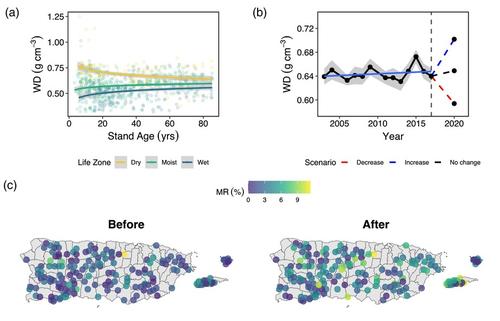Our official English website, www.x-mol.net, welcomes your
feedback! (Note: you will need to create a separate account there.)
Aridity and forest age mediate landscape scale patterns of tropical forest resistance to cyclonic storms
Journal of Ecology ( IF 5.3 ) Pub Date : 2024-11-04 , DOI: 10.1111/1365-2745.14437 German Vargas G., Humfredo Marcano‐Vega, Tom Ruzycki, Tana E. Wood, William R. L. Anderegg, Jennifer S. Powers, Eileen H. Helmer
Cyclonic storms, or hurricanes, are expected to intensify as ocean heat energy rises due to climate change. Ecological theory suggests that tropical forest resistance to hurricanes should increase with forest age and wood density. However, most data on hurricane effects on tropical forests come from a limited number of well‐studied long‐term monitoring sites, restricting our capacity to evaluate the resistance of tropical forests to hurricanes across broad environmental gradients. In this study, we assessed whether forest age and aridity mediate the effects of hurricanes Irma and Maria in Puerto Rico, Vieques and Culebra islands. We leveraged functional trait data for 410 tree species, remotely sensed measurements of canopy height and cover, along with data on forest stand characteristics of 180 of 338 forest monitoring plots, each covering an area of 0.067 ha. The plots represent a broad mean annual precipitation (MAP) gradient from 701 to 4598 mm and a complex mosaic of forest age from 5 to around 85 years since deforestation. Hurricanes resulted in a 25% increase in basal area mortality rates, a 45% decrease in canopy height and a 21% reduction in canopy cover. These effects intensified with forest age, even after considering proximity to the hurricane path. The links between forest age and hurricane disturbances were likely due the prevalence of tall canopies. Tall forest canopies were strongly linked with low community‐weighted wood density (WD). These characteristics were on average more common in moist and wet forests (MAP >1250 mm). Conversely, dry forests were dominated by short species with high wood density (WD > 0.6 g cm−3 ) and did not show significant increases in basal area mortality rates after the hurricanes. Synthesis . Our findings show that selection towards drought‐tolerant traits across aridity gradients, such as short stature and dense wood, enhances resistance to hurricanes. However, forest age modulated responses to hurricanes, with older forests being less resistant across the islands. This evidence highlights the importance of considering the intricate links between ecological succession and plant function when forecasting tropical forests’ responses to increasingly strong hurricanes.
中文翻译:

干旱和森林年龄介导了热带森林抵抗气旋风暴的景观尺度模式
随着气候变化导致海洋热能的增加,预计气旋风暴或飓风将加剧。生态学理论表明,热带森林对飓风的抵抗力应随着森林年龄和木材密度的增加而增加。然而,大多数关于飓风对热带森林影响的数据来自有限数量的经过充分研究的长期监测站点,这限制了我们在广泛的环境梯度上评估热带森林对飓风的抵抗力的能力。在这项研究中,我们评估了森林年龄和干旱是否介导了飓风艾尔玛和玛丽亚对波多黎各、别克斯岛和库莱布拉群岛的影响。我们利用了 410 种树种的功能性状数据、树冠高度和覆盖的遥感测量数据,以及 338 个森林监测地中 180 个的林分特征数据,每个监测地的面积为 0.067 公顷。这些图代表了从 701 到 4598 毫米的广泛平均年降水量 (MAP) 梯度,以及自森林砍伐以来 5 年至 85 年左右的林龄的复杂马赛克。飓风导致基底面积死亡率增加 25%,树冠高度降低 45%,树冠覆盖率降低 21%。这些影响随着森林年龄的增长而加剧,即使在考虑到靠近飓风路径之后也是如此。森林年龄与飓风干扰之间的联系可能是由于高大树冠的普遍存在。高大的森林树冠与较低的社区加权木材密度 (WD) 密切相关。这些特性在潮湿和潮湿的森林中平均更常见 (MAP >1250 mm)。相反,干旱森林以木材密度高 (WD > 0.6 g cm-3) 的矮树种为主,飓风过后基底面积死亡率没有显着增加。合成。 我们的研究结果表明,在干旱梯度上选择耐旱性状,例如身材矮小和茂密的木材,可以增强对飓风的抵抗力。然而,森林年龄调节了对飓风的反应,岛上较老的森林抵抗力较弱。这些证据凸显了在预测热带森林对日益强烈的飓风的反应时,考虑生态演替和植物功能之间错综复杂的联系的重要性。
更新日期:2024-11-04
Journal of Ecology ( IF 5.3 ) Pub Date : 2024-11-04 , DOI: 10.1111/1365-2745.14437 German Vargas G., Humfredo Marcano‐Vega, Tom Ruzycki, Tana E. Wood, William R. L. Anderegg, Jennifer S. Powers, Eileen H. Helmer

|
中文翻译:

干旱和森林年龄介导了热带森林抵抗气旋风暴的景观尺度模式
随着气候变化导致海洋热能的增加,预计气旋风暴或飓风将加剧。生态学理论表明,热带森林对飓风的抵抗力应随着森林年龄和木材密度的增加而增加。然而,大多数关于飓风对热带森林影响的数据来自有限数量的经过充分研究的长期监测站点,这限制了我们在广泛的环境梯度上评估热带森林对飓风的抵抗力的能力。在这项研究中,我们评估了森林年龄和干旱是否介导了飓风艾尔玛和玛丽亚对波多黎各、别克斯岛和库莱布拉群岛的影响。我们利用了 410 种树种的功能性状数据、树冠高度和覆盖的遥感测量数据,以及 338 个森林监测地中 180 个的林分特征数据,每个监测地的面积为 0.067 公顷。这些图代表了从 701 到 4598 毫米的广泛平均年降水量 (MAP) 梯度,以及自森林砍伐以来 5 年至 85 年左右的林龄的复杂马赛克。飓风导致基底面积死亡率增加 25%,树冠高度降低 45%,树冠覆盖率降低 21%。这些影响随着森林年龄的增长而加剧,即使在考虑到靠近飓风路径之后也是如此。森林年龄与飓风干扰之间的联系可能是由于高大树冠的普遍存在。高大的森林树冠与较低的社区加权木材密度 (WD) 密切相关。这些特性在潮湿和潮湿的森林中平均更常见 (MAP >1250 mm)。相反,干旱森林以木材密度高 (WD > 0.6 g cm-3) 的矮树种为主,飓风过后基底面积死亡率没有显着增加。合成。 我们的研究结果表明,在干旱梯度上选择耐旱性状,例如身材矮小和茂密的木材,可以增强对飓风的抵抗力。然而,森林年龄调节了对飓风的反应,岛上较老的森林抵抗力较弱。这些证据凸显了在预测热带森林对日益强烈的飓风的反应时,考虑生态演替和植物功能之间错综复杂的联系的重要性。


















































 京公网安备 11010802027423号
京公网安备 11010802027423号